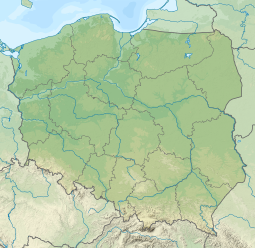Niemica (river)
| Niemica | |
|---|---|

The Niemica near Mokrawica
|
|
|
The location of the Niemica (specifically, its mouth) on a map of Poland
|
|
| Country | Poland |
| Voivodeship | West Pomeranian Voivodeship |
| Powiat | Kamień County |
| Villages | Szumiąca, Mokrawica |
| Basin features | |
| Main source | South of Lake Żabie in the West Pomeranian Voivodeship, near Szczecin 53°49′30″N 15°01′20″E / 53.82500°N 15.02222°E |
| River mouth | the Świniec River; north of Borucin and east of Grabowo 53°58′25″N 14°49′09″E / 53.97361°N 14.81917°ECoordinates: 53°58′25″N 14°49′09″E / 53.97361°N 14.81917°E |
| Progression | Niemica-Świniec-Dziwna |
| River system | Oder |
| Basin size | 112.6 km2 (43.5 sq mi) |
| Physical characteristics | |
| Length | 27 km (17 mi) |
The Niemica [ɲeˈmit͡sa] River is a river in Poland. It is a tributary of the Świniec River.
It is 27 kilometres (17 mi) long, and has a basin size of 112.6 square kilometres (43.5 sq mi). Its source is located south of Lake Żabie (though that lake is located in a different river basin), by the No. 420 railway line.
Initially, the river flows in a south-westerly direction to Lake Szczucze, at which it flows into the fishponds adjacent to the lake's south-eastern shore. It leaves the lake at its northern shore, and after about 250 metres (820 ft) it enters Lake Okonie. Next, it flows from the north-western shore of Lake Okonie and flows in a north-westerly direction to the east of the village Niemica, then travelling further north through the village of Szumiąca and afterwards continuing in a north-westerly direction, where it passes through the village of Mokrawica. Flowing in its final section along the Trzebiatowski Coast, it flows into the Świniec River to the east of the village of Grabowo, near Kamień Pomorski. The Świniec carries on moving to the west, where it meets the Kamieński Lagoon, part of the Dziwna.
The name Niemica has been used officially since 1948, replacing the river's earlier German name of Niemitz Bach (the whole area only became part of Poland in 1945, as part of the territorial changes of Poland immediately after World War II).
In 1958, a Bronze-Age (or possibly early Iron-Age) settlement was discovered on the river's right bank, by the road to the village of Benice. It was part of the Lusatian culture.
...
Wikipedia

